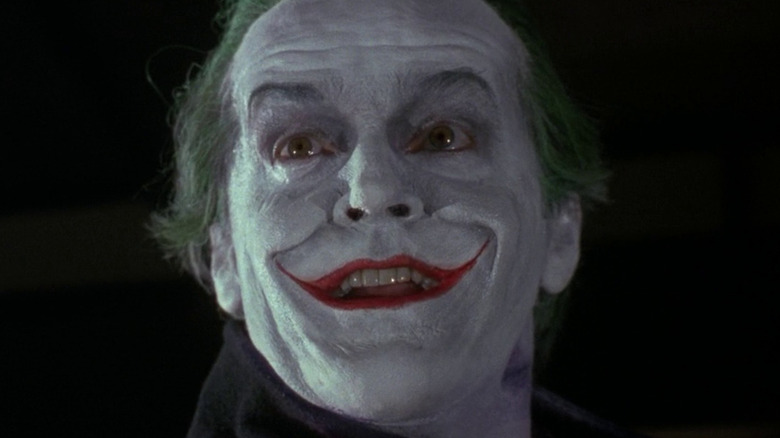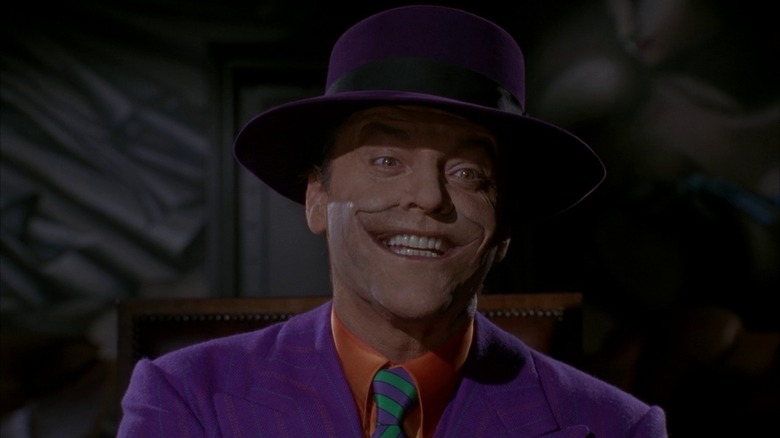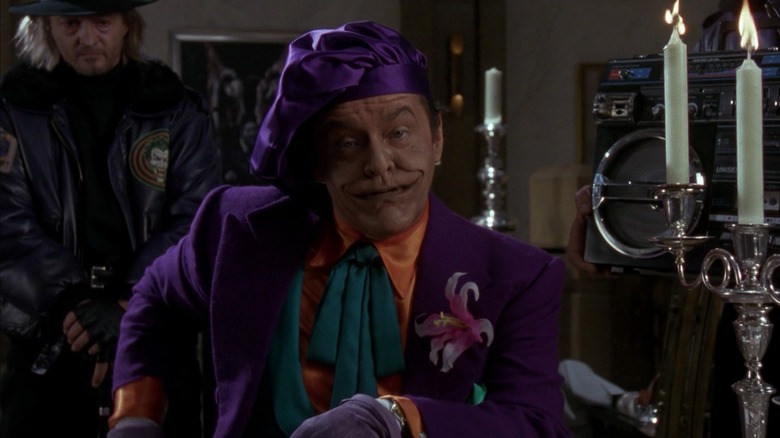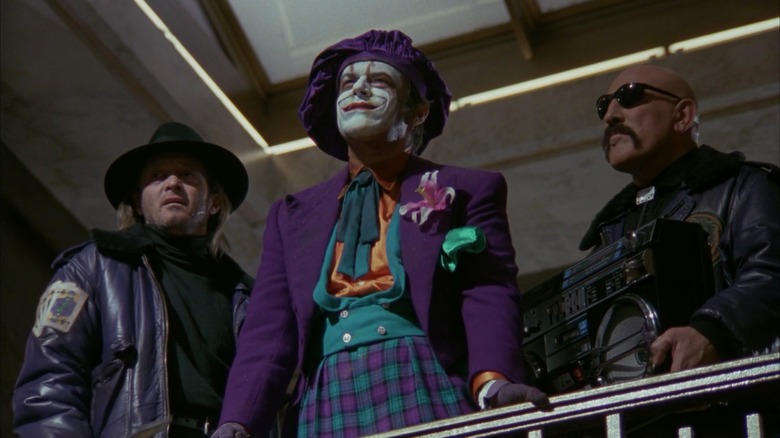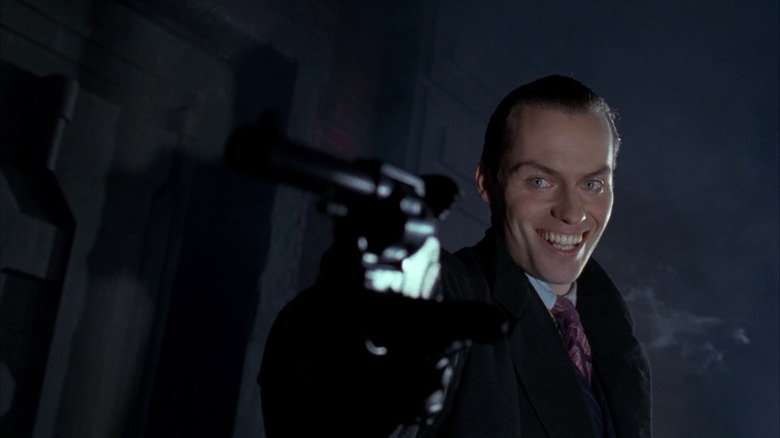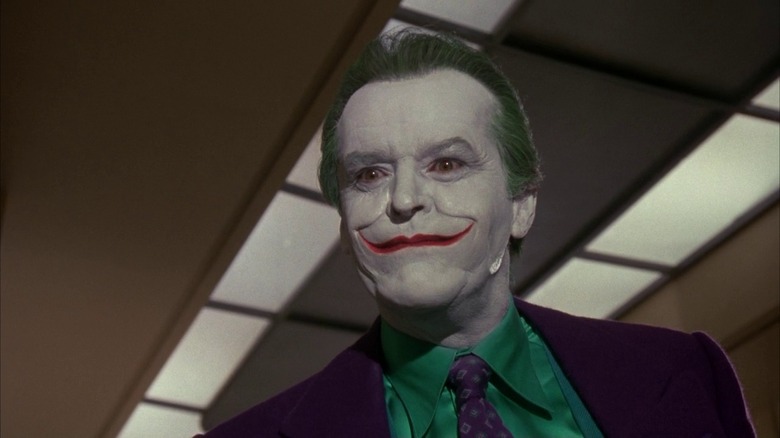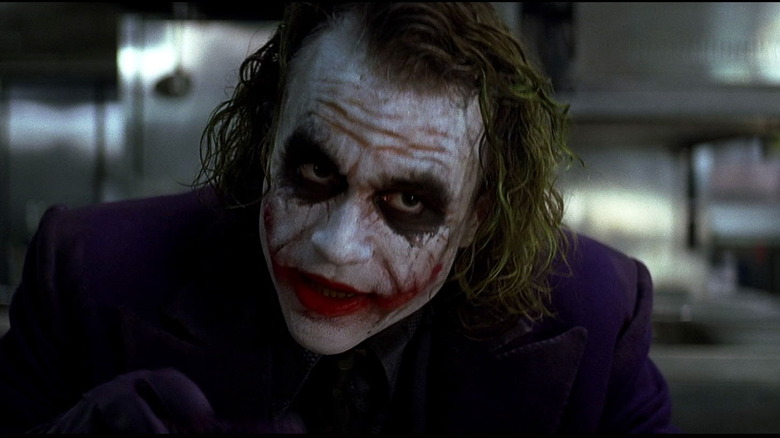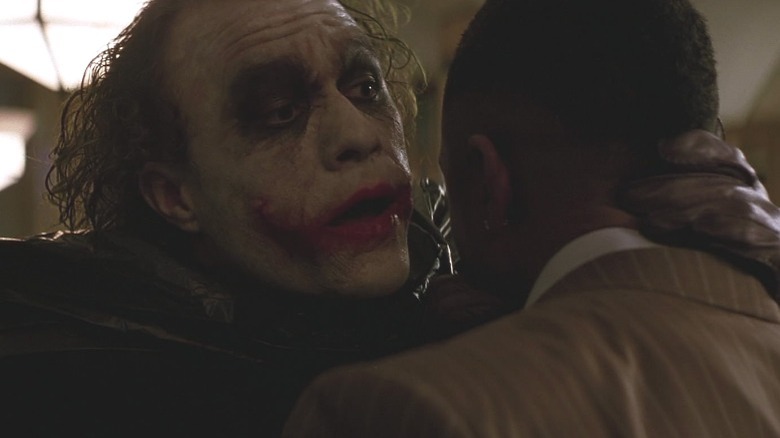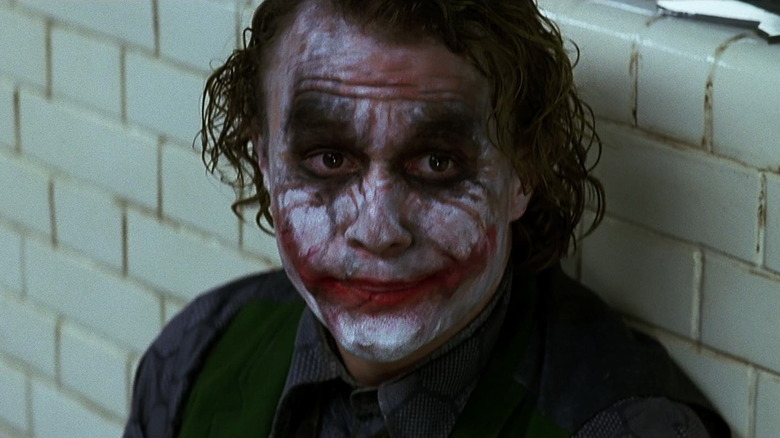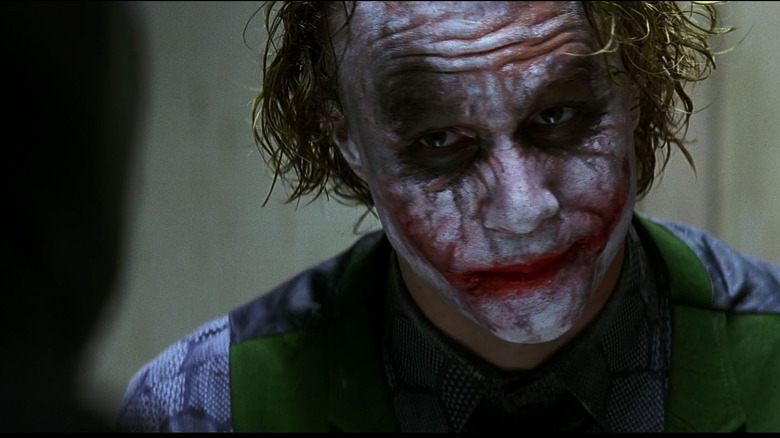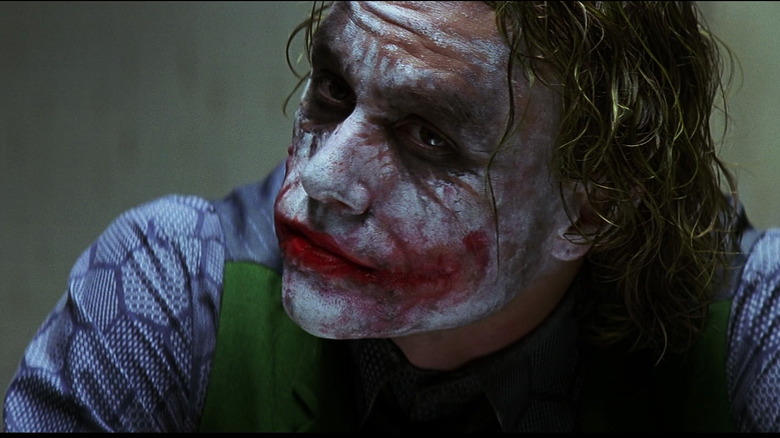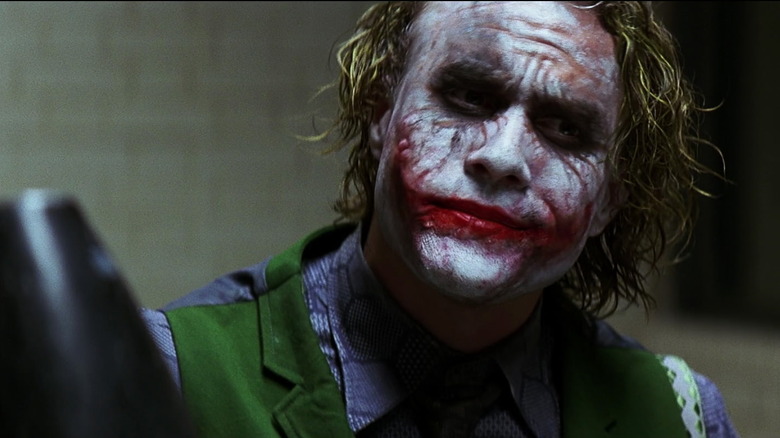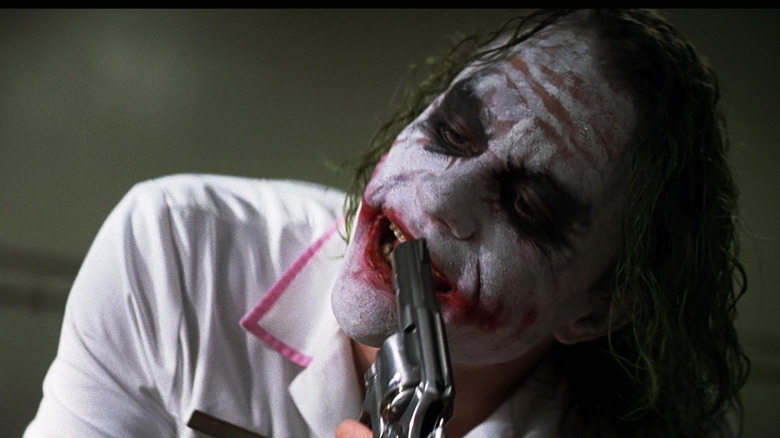Most Memorable Quotes From The Joker In The Batman Movies
While he's made small appearances in other feature films (and starred in his own off-canon solo movie), Batman's arch-nemesis The Joker has so far headlined two major blockbusters opposite the Caped Crusader: 1989's "Batman" and 2008's "The Dark Knight." In the former, he's played by legendary actor Jack Nicholson, and in the latter by the late Heath Ledger, who won his only Oscar, posthumously, for the role.
Bringing the Joker to life is, of course, a multi-faceted undertaking. It requires the right wardrobe, the right makeup, the right actor and, naturally, the right script. In both Nicholson's incarnation and Ledger's, we got numerous memorable lines out of Joker as he battled Batman across Gotham City, but even though there are dozens of memorable quips between the two performances, a few stand out as the best of the best. So, from musings on the nature of good and evil to some good old-fashioned double entendres, these are the best lines Joker ever got to say in Batman movies...so far.
The healing process
Jack Nicholson's Joker is an interesting standout in Batman lore, in no small part because we know who he is from the moment he steps onscreen in Tim Burton's 1989 "Batman" film. There's no mystery to his identity, no sense of artifice about what he's after. He's just a bad guy who turns into a crazy bad guy after falling into a vat of chemicals and transforming into the Clown Prince of Crime.
It's fascinating to watch the ways in which Nicholson informs that aspect of the character, and one of the key moments in the transformation is the scene in which Jack "Joker" Napier informs the other Gotham City crime lords that he's now the man in charge. When one of them dares to challenge him, he activates a deadly hand buzzer that burns the guy to a crisp, laughing all the while. When yet another crime lord dares to call him crazy, he responds with:
"Haven't you ever heard of the healing power of laughter?"
It's a joke, yes, but it's also an interesting insight into who this version of Joker is. Jack Napier's been wounded, but he's also been freed by those wounds, transformed into something even more daring, even more heedless of morality. It's both frightening and very fitting for the character.
Joker the artist
While many versions of the Joker lean heavily into the character's inherent mystery, never especially caring about motives or desires beyond destruction, Nicholson's Joker in "Batman" does seem to want more than just absolute chaos at all times. In fact, he especially seems to want Vicki Vale (Kim Basinger), Bruce Wayne's (Michael Keaton) new lover and photographer extraordinaire. He wants her so much, in fact, that he's willing to stage a date for the two of them at an art museum in what has become one of the film's most iconic sequences.
After trashing the museum with his goons and poisoning the rest of the guests, Joker sits down with Vicki to explain why, in his mind, they're meant for each other. He's drawn to her photographs of war and genocide, but instead of seeing them as efforts to document atrocities, he views them as fine art depicting the beauty of death, something he's also fascinated by. But he's not just into her pictures because they're creepy. He also tries to lay out a particular aesthetic and describes himself like this:
"I am the world's first fully functioning homicidal artist."
Does he mean it? Maybe not. Maybe it's just a tactic to get closer to Vicki, but it's also indicative of this Joker's larger place as a performative figure in "Batman." He's not just a villain, or at least he doesn't think he is. He genuinely wants to make an impression on people beyond just killing them.
Batman's toys
There's a very interesting dynamic between Batman and the Joker in 1989's "Batman," much of it stemming from the understanding that, in their own way, they made each other. It takes Bruce Wayne a little while to figure out, but Joker knows it right away, and it creates an adversarial relationship that, at times, veers into outright jealousy.
One of the interesting subplots of "Batman" is the way in which Joker seeks to build his own legend alongside Batman's, whose place in Gotham lore is growing without any sense of self-generated publicity. Joker, for his part, is all about self-generated publicity, so when he corners Vicki Vale after a rampage through the art museum, he feels like he's doing very well for himself and his status. Then, of course, Batman has to interfere, and deploys a launcher that zips him and Vicki up and out of the museum almost instantly. That leaves Joker to lament:
"Where does he get those wonderful toys?"
It's a great line because it plays on both characters' love of gadgets, but it's also a deeper look at Joker's own insecurities with regard to Batman, insecurities that will play out even more later in the film.
Joker's catchphrase
In most of his incarnations, Joker is a natural showman. It's the "Clown" part of his "Clown Prince of Crime" persona. He just can't help but make everything at least a little bit theatrical. Apparently that was the case even before he was actually the Joker, at least as far as "Batman" (the film) is concerned.
When Bruce Wayne pays a visit to Vicki Vale's apartment, the two of them are cornered by Joker and his gang, and Joker decides it's time to get this millionaire playboy out of his love life. So he raises his pistol and asks:
"You ever dance with the devil in the pale moonlight?"
When Wayne looks puzzled, Joker clarifies that it's just something he says to everyone he kills, because he likes the sound of it. Narratively, of course, this plays a big role in Bruce Wayne remembering that it's the same thing the man who shot his parents said years earlier. That cements Jack Napier as the man who made Batman, just as Batman inadvertently made the Joker. That's important, but beyond that, the line just works because it makes clear that Jack Napier has always been an egotistical showman who wants to showcase himself above all else.
Joker's silliness
There have been many different incarnations of the Joker since the character's first appearance way back in 1940, ranging from the absolutely terrifying to the totally campy. Everyone has the version they prefer, and every creator who takes a crack at the character — whether they're writing him, drawing him, or playing him — has their own ideas about what the Clown Prince of Crime should be.
For "Batman," Nicholson created an interesting bridge between the campy Joker fans remembered from the 1966 TV series and the more modernized, terrifying killer clown many contemporary fans prefer. He's undeniably scary, but he's also very silly, and his ability to pivot between moments of absolute homicidal savagery and moments of sheer goofiness ultimately serve to make him even scarier. One of these moments arrives just after he shoots, and believes he's killed, Bruce Wayne. In a moment when he's murdered someone for being with the woman he likes, Joker decides it's the right time to declare:
"Never rub another man's rhubarb."
It's such a goofy line, and yet it absolutely works for this incarnation of the character.
Joker's price
Heath Ledger's incarnation of the Joker makes his first full appearance (after staying hidden for much of the opening bank robbery sequence) in "The Dark Knight" during a meeting of Gotham City's mob elite. After the key figures in the city's underworld realize that Batman is becoming a serious threat to their future business, Joker emerges, performs a particularly brutal "magic trick" on a mob enforcer, and tells them the solution to their problems is, of course, to kill Batman.
Naturally, one of the mobsters is unimpressed. He asks Joker why, if he's so sure it's possible, he hasn't done it already. Joker responds:
"If you're good at something, never do it for free."
It makes sense to the money hungry gangsters, but of course later in the film Joker ends up setting fire to the money he collects. The true cost of doing business with him is never monetary. The cost is the status quo in Gotham City. The cost is the city's own sanity. The cost is dealing with this man and his power and influence for as long as he cares to rule the streets. It's an early sign that, when it comes to this Joker, it's hard to take anything at face value.
Joker's scars
Unlike other versions of Joker, whose face is fixed in a rictus grin thanks to a chemical accident, the version in "The Dark Knight" has a smile made of scars, which he paints over with bright red makeup for extra emphasis. The scars are certainly visually distinctive, and they add extra dimension to the character, particularly when Joker spends more than one scene asking a would-be victim:
"You wanna know how I got these scars?"
On two separate occasions, once with a fellow criminal and once with Bruce Wayne's lifelong friend Rachel Dawes (Maggie Gyllenhaal), Joker tells an elaborate yarn about how the scars came to be. In one version, his abusive father gave them to him. In another, they're self-inflicted scars to try and lighten the trauma of his wife, who had her own face scarred by criminals. Both are horrifying stories, but which one is true? Are neither of them true? Are both of them true in Joker's strange mind? It's impossible to know, and that's one of the cornerstones of this version of the character. He's an enigma through and through, and he likes it that way.
Weapon of choice
Midway through "The Dark Knight," Batman and Commissioner Gordon manage to capture Joker after a high-speed chase through Gotham's streets. When the villain gets back to the precinct, cops find "nothing in his pockets but knives and lint," and we see a whole row of bladed weapons lined up on a table, emphasizing the character's devotion to up-close murder.
A few minutes later, Joker gets to spend a little quality time with a Gotham detective, where he muses:
"Do you want to know why I use a knife?"
His answer: Guns are "too quick," because you can't really observe all the little moments that come before a person dies. To Joker, watching someone die slowly reveals who they truly are. With that knowledge in mind, he asks the detective if he'd like to know which of his fellow officers — officers Joker killed — are cowards.
This is all, of course, in service to Joker's ultimate goal of escaping jail by provoking the cops into giving him leverage. But even with that motive in mind, it's a chilling declaration of the character's proclivities.
Joker and Batman
One of the key scenes in "The Dark Knight" comes when Batman sits down across from Joker in an interrogation room in an effort to finally understand and unravel the plots of the Clown Prince. It's a phenomenal scene featuring great performances from both Heath Ledger and Christian Bale, and it features several of the film's best lines.
At one point in their conversation, Batman alludes to Joker killing him, which prompts Joker to burst into laughter and declare:
"I don't want to kill you. What would I do without you? Go back to ripping off mob dealers? No, no ... you complete me."
This is especially interesting because, earlier in the film, Joker did say that he could and would kill Batman for the city's mob leaders. That suggests that he either never intended to do that, or backed off the idea once he realized just how much fun being Batman's opposite could truly be. Either way, it's an almost formal declaration of the elaborate dance between the characters, a dance that's been going on in some form or another for decades.
A pair of freaks
Elsewhere in the interrogation room showdown, Batman and the Joker spar over how they relate to each other as key figures in Gotham City. Joker argues that they're actually more alike than Batman would care to admit. Batman responds that Joker is "garbage who kills for money," and Joker reacts with a perfect response:
"Don't talk like one of them, you're not. Even if you'd like to be."
Joker's declaration that Batman is not "one of them," meaning cops, is prescient: Batman will ultimately become an even greater fugitive by the end of the film, and a scapegoat that allows Gotham to seemingly evolve beyond him by the time of "The Dark Knight Rises." Joker goes on to declare that, to everyone else, Batman is "just a freak, like me." His musings play into the film's larger exploration of how Batman's outsized persona within Gotham helps to create other outsized personas, and how Batman's presence in Gotham is further justified by the rise of people like Joker. In other words, they feed each other through their behavior, even if Batman doesn't want to admit it.
Ahead of the curve
One of the overarching thematic concerns of "The Dark Knight" is the nature of evil, and how quickly seemingly good people can be persuaded to compromise their integrity for the sake of safety, convenience, or survival. At the center of this arc is the Joker, who views himself as a provocateur whose job is not just to commit crimes and defeat his enemies, but to provoke change in the larger populace of Gotham City. For him, it's a mission to prove that just about anyone can change their ways.
This mission to introduce change, to provoke transgression, includes Batman, and that becomes very clear as Batman's rage builds during their interrogation room conversation. Joker is trying to prove to his adversary that the only way to defeat him is to change, to be willing to go further than he's ever gone before. Batman, of course, is unwilling to go so far as to kill the Joker, resisting Joker's idea that breaking his personal code is the only way to move forward. In response, Joker declares:
"See, I'm not a monster. I'm just ahead of the curve."
Joker's need to be proven right in that statement, and Batman's quest to prove him wrong, make up the meat of the entire rest of the movie.
Joker's plan
By the third act of "The Dark Knight," Joker's acts of destruction have killed Rachel Dawes and sent Harvey Dent to the hospital with half his face burned off, while Batman is still scrambling to contain the chaos sown by his nemesis. In the midst of that, Joker shows up in Harvey's hospital room and decides to try to convert him to his way of seeing things. When Harvey makes reference to Joker's "plan," Joker responds:
"Do I really look like a guy with a plan?"
He goes on to describe himself as an "agent of chaos," there to upset the established order and let the "fair" feeling of anarchy overwhelm the city, something that Harvey seems to both understand and appreciate. The irony, of course, is that Joker does have a plan, even if we're not entirely aware of his endgame. He's carefully orchestrated so much of what's happening in the movie, whether he'll admit it or not, that it's impossible to separate events from his planning. He goes to great lengths to prove to Batman that anyone is corruptible, and that requires very intense planning. The chaos, of course, is in both his ability to improvise, and in the results he gets.
